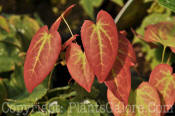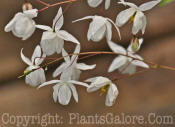 The foliage of epimediums
is called "semi-evergreen" which means that,
in areas with mild winters, the foliage
maintains itself through the winter. In
severe winters, the foliage may be damaged
and need to be cut down in the early spring
to encourage new growth.
The foliage of epimediums
is called "semi-evergreen" which means that,
in areas with mild winters, the foliage
maintains itself through the winter. In
severe winters, the foliage may be damaged
and need to be cut down in the early spring
to encourage new growth.
They have compound leaves
with 3 leaflets of a leathery texture. Most
of them have smooth, shiny leaves during the
growing season. The new foliage may emerge
with shades of red before turning dark
green. At the end of the season, may
epimediums display a bronze to red foliage.
The flowers are delicate
and droop or nod from the flower scape. They
have 4 inner and 4 outer sepals and may be
spurred or hooded. Epimediums rarely set
seed which might indicate that they are
self-sterile.
 Overall, this species is
easy to grow but will not tolerate full sun
and dry soils. In shade with adequate
moisture, they will spread their
rhizomes
slowly to fill an area as a ground cover.
Overall, this species is
easy to grow but will not tolerate full sun
and dry soils. In shade with adequate
moisture, they will spread their
rhizomes
slowly to fill an area as a ground cover.
In historical times, a
drug meant to prevent women from conception
was extracted from the root of a plant that
resembles epimedium. Thus the common name of
"Barrenwort."
People thought that the 4
sepaled flowers resembled the typical
"Bishop's Hat" common in earlier times.



